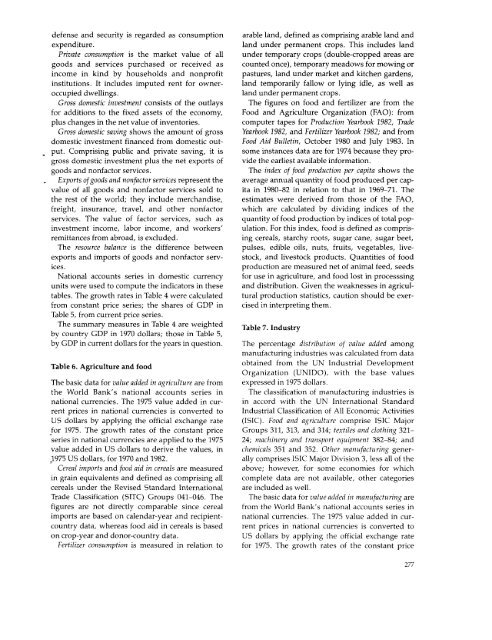World Development Report 1984
World Development Report 1984
World Development Report 1984
You also want an ePaper? Increase the reach of your titles
YUMPU automatically turns print PDFs into web optimized ePapers that Google loves.
defense and security is regarded as consumption arable land, defined as comprising arable land and<br />
expenditure. land under permanent crops. This includes land<br />
Private consumption is the market value of all under temporary crops (double-cropped areas are<br />
goods and services purchased or received as counted once), temporary meadows for mowing or<br />
income in kind by households and nonprofit pastures, land under market and kitchen gardens,<br />
institutions. It includes imputed rent for owner- land temporarily fallow or lying idle, as well as<br />
occupied dwellings, land under permanent crops.<br />
Gross domestic investment consists of the outlays The figures on food and fertilizer are from the<br />
for additions to the fixed assets of the economy, Food and Agriculture Organization (FAO): from<br />
plus changes in the net value of inventories. computer tapes for Production Yearbook 1982, Trade<br />
Gross domestic saving shows the amount of gross Yearbook 1982, and Fertilizer Yearbook 1982; and from<br />
domestic investment financed from domestic out- Food Aid Bulletin, October 1980 and July 1983. In<br />
put. Comprising public and private saving, it is some instances data are for 1974 because they progross<br />
domestic investment plus the net exports of vide the earliest available information.<br />
goods and nonfactor services. The index of food production per capita shows the<br />
Exports of goods and nonfactor services represent the average annual quantity of food produced per capvalue<br />
of all goods and nonfactor services sold to ita in 1980-82 in relation to that in 1969-71. The<br />
the rest of the world; they include merchandise, estimates were derived from those of the FAO,<br />
freight, insurance, travel, and other nonfactor which are calculated by dividing indices of the<br />
services. The value of factor services, such as quantity of food production by indices of total popinvestment<br />
income, labor income, and workers' ulation. For this index, food is defined as comprisremittances<br />
from abroad, is excluded. ing cereals, starchy roots, sugar cane, sugar beet,<br />
The resource balance is the difference between pulses, edible oils, nuts, fruits, vegetables, liveexports<br />
and imports of goods and nonfactor serv- stock, and livestock products. Quantities of food<br />
ices. production are measured net of animal feed, seeds<br />
National accounts series in domestic currency for use in agriculture, and food lost in processsing<br />
units were used to compute the indicators in these and distribution. Given the weaknesses in agricultables.<br />
The growth rates in Table 4 were calculated tural production statistics, caution should be exerfrom<br />
constant price series; the shares of GDP in cised in interpreting them.<br />
Table 5, from current price series.<br />
The summary measures in Table 4 are weighted Table 7. Industry<br />
by country GDP in 1970 dollars; those in Table 5,<br />
by GDP in current dollars for the years in question. The percentage distribution of value added among<br />
manufacturing industries was calculated from data<br />
Table 6. Agriculture and food obtained from the UN Industrial <strong>Development</strong><br />
Organization (UNIDO), with the base values<br />
The basic data for value added in agriculture are from expressed in 1975 dollars.<br />
the <strong>World</strong> Bank's national accounts series in The classification of manufacturing industries is<br />
national currencies. The 1975 value added in cur- in accord with the UN International Standard<br />
rent prices in national currencies is converted to Industrial Classification of All Economic Activities<br />
US dollars by applying the official exchange rate (ISIC). Food and agriculture comprise ISIC Major<br />
for 1975. The growth rates of the constant price Groups 311, 313, and 314; textiles and clothing 321series<br />
in national currencies are applied to the 1975 24; machinery and transport equipment 382-84; and<br />
value added in US dollars to derive the values, in chemicals 351 and 352. Other manufacturing gener-<br />
1975 US dollars, for 1970 and 1982. ally comprises ISIC Major Division 3, less all of the<br />
Cereal imports and food aid in cereals are measured above; however, for some economies for which<br />
in grain equivalents and defined as comprising all complete data are not available, other categories<br />
cereals under the Revised Standard International are included as well.<br />
Trade Classification (SITC) Groups 041-046. The The basic data for value added in manufacturing are<br />
figures are not directly comparable since cereal from the <strong>World</strong> Bank's national accounts series in<br />
imports are based on calendar-year and recipient- national currencies. The 1975 value added in curcountry<br />
data, whereas food aid in cereals is based rent prices in national currencies is converted to<br />
on crop-year and donor-country data. US dollars by applying the official exchange rate<br />
Fertilizer consumption is measured in relation to for 1975. The growth rates of the constant price<br />
277









